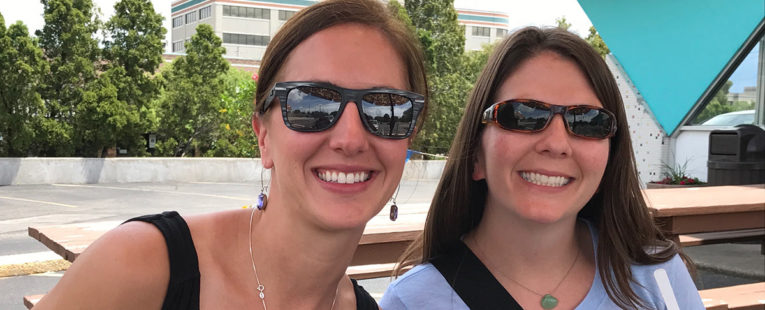Sara Krzyzaniak’s first forays into health care were make-believe.
“My younger sister and I would play with dolls,” Sara said. “She would nurture them, and I would stick pins in them to give them shots.”
A career in health care was rarely if ever in doubt. Sara’s mother was an ultrasound technologist, her father a non-physician administrator in radiology. Sara, her brother and sister, Andrew and Kathryn Medendorp, would hang around the hospital. She remembers marveling at the medical equipment and playing hide-and-seek in the file room.
So it’s really no surprise that today she is Sara Krzyzaniak, MD, a physician at OSF HealthCare Saint Francis Medical Center in Peoria. But of all the specialties available to physicians, how did she wind up in the Emergency Department – and loving it?
Emergency medicine is a puzzle
 As a youngster, Dr. Krzyzaniak religiously watched the television program “Rescue 911,” hosted by William Shatner.
As a youngster, Dr. Krzyzaniak religiously watched the television program “Rescue 911,” hosted by William Shatner.
“I loved that show,” she said.
She also played emergency-room computer games on her desktop at home. She enjoyed doing puzzles, too.
“Emergency medicine is a constant puzzle,” Dr.Krzyzaniak said. “I like to take a patient’s symptoms and figure out what’s going on.”
Variety is the spice of the ED

Dr. Sara Krzyzaniak at the annual George Washington Day Banquet in Peoria.
Life as an ED physician is anything but routine. Dr. Krzyzaniak works day shifts, overnight shifts, weekend shifts. No two days are ever alike. Some days might be free of TV-style drama, but that can change in a blink. One minute, she might be trying to diagnose the source of a child’s abdominal pain. The next minute might bring a family involved in a multi-vehicle accident.
Dr. Krzyzaniak’s older brother is a urologist, and he enjoys good-naturedly picking on her about not having a more traditional, clinical specialty.
“Some people say that in emergency medicine, you’re a jack of all trades, master of none,” Dr. Krzyzaniak said. “But I really think we are the masters of a lot of things. We’re masters of resuscitation, masters of diagnosis and masters of acute care, among other clinical skills.
“I like that variety. I like that I might be managing nine different patients at one time, constantly running this list through my head about what each patient needs and what we need to do for each of them. I like that I could deliver a baby and then take care of a kid with a fever and then have someone with appendicitis.”
One thing emergency physicians miss out on is the patient’s journey. They do their work, the patient moves on to other doctors, and the ED is forgotten.
But not always.
The quintessential emergency
 A few years ago, Dr. Krzyzaniak resuscitated a woman who arrived in the ED experiencing cardiac arrest. Several months later, Dr. Krzyzaniak was working out at the gym when a young man approached her.
A few years ago, Dr. Krzyzaniak resuscitated a woman who arrived in the ED experiencing cardiac arrest. Several months later, Dr. Krzyzaniak was working out at the gym when a young man approached her.
“Aren’t you a doctor?” he asked.
“Yes,” she replied.
“You saved my mom’s life,” the man told her. “She’s her old self now, and we’re so happy to have her around.”
Dr. Krzyzaniak shook her head at the memory.
“That still gives me goosebumps,” she said.
Learn about opportunities in the Emergency Department at osfcareers.org.
Last Updated: November 27, 2020
